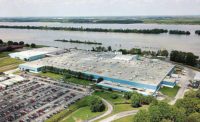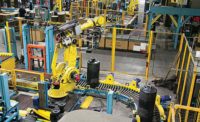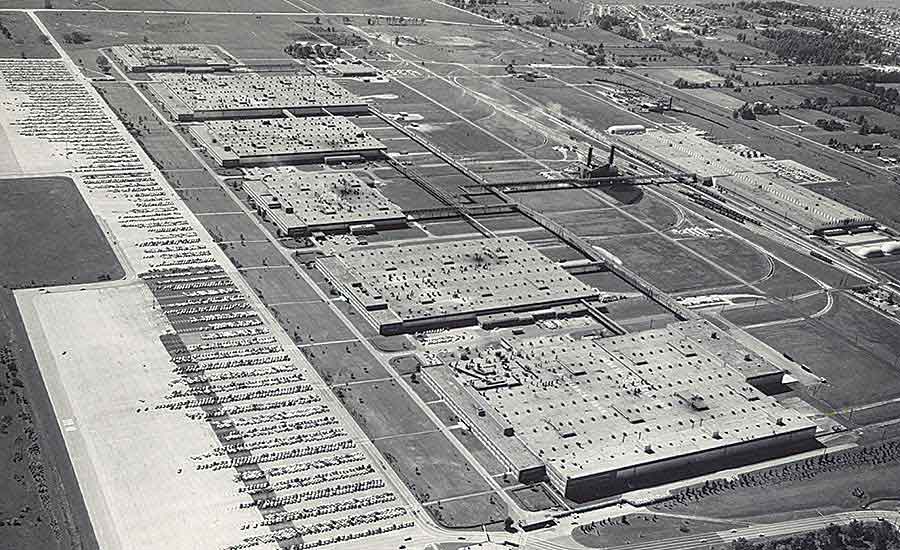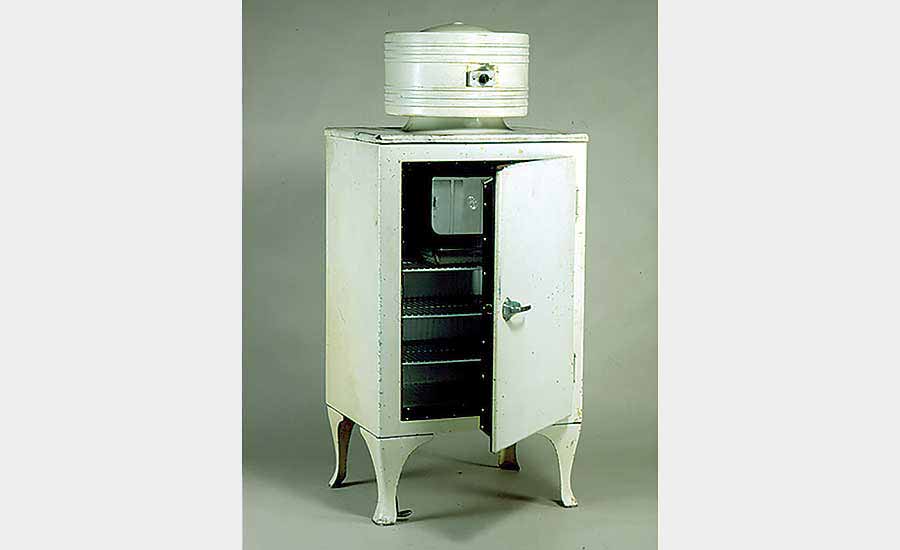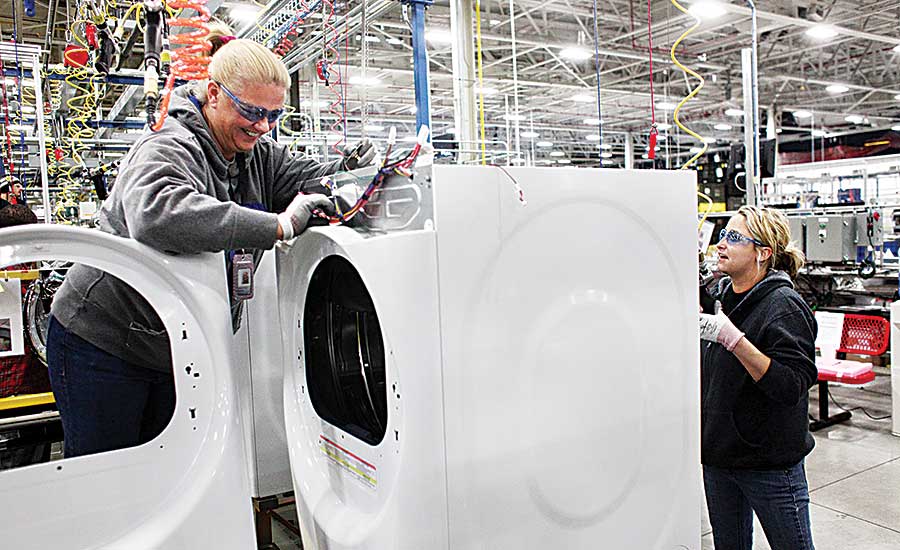A Century of GE Appliance Manufacturing
GE Appliances have a long history of innovation in product development and on the assembly line.

This aerial photo shows Appliance Park in 1963. The 920-acre campus sports 12 miles of paved road and 20 miles of railroad track. It even has its own ZIP code. Photo courtesy General Electric

GE introduced the “Monitor-Top” refrigerator in 1927. In its first year, it captured 7 percent of the domestic refrigerator market, and the company would eventually produce more than a million units. Photo courtesy Museums Victoria

In 1953, Appliance Park leased a UNIVAC computer from Remington Rand. At that time, there were only six such computers in existence, and the U.S. government owned five of them. Photo courtesy Computer History Museum

A worker assembles a washing machine at GE’s Appliance Park. Photo courtesy General Electric

In February 2012, GE opened a newly renovated water heater assembly plant at Appliance Park, the first new factory to open there since 1957. Photo courtesy General Electric

In 1972, employment at Appliance Park reached a peak of 23,000 people. Today, the park employs approximately 6,000. Photo courtesy General Electric






In June 2016, General Electric sold its century-old appliances business to Chinese manufacturer Quingdao Haier Co. Ltd. for $5.4 billion. GE Appliance’s headquarters will remain in Louisville, KY, and the agreement calls for the business to continue to market the current portfolio of GE brands for at least 40 years.
“The sale of GE Appliances is another step in the company’s portfolio transformation and its mission to become the world’s leading digital-industrial company,” said GE Chairman and CEO Jeff Immelt in a news release.
“Haier has a stated focus to grow in the U.S., build their manufacturing presence here, and to invest further in the business,” he added. “Innovation, new product introduction and brand management are fundamental to their overall strategy.”
The sale marks the end of an era for GE, the industrial conglomerate, though not for GE, the appliance brand. Regardless of ownership, GE Appliances will always be able to lay claim to a proud history indeed.
During the past 100 years, GE’s Appliances division has weathered labor strife, recessions, energy crises and intense foreign and domestic competition to remain one of the world’s most well-known and well-regarded brands. At one point, GE was the largest appliance manufacturer in the world, employing tens of thousands of people making refrigerators, stoves, washing machines, dishwashers, air conditioners, garbage disposals and other products.
GE Appliances has a long history of innovation in product design, including the first successful residential refrigerator, the first fully automatic washing machine, the first food-waste disposer, the first heat pump climate control system, and the first self-cleaning oven.
The company was an innovator on the shop floor, too. It was an early adopter of plastic molding technologies, computers and robotics. Its evangelism of Six Sigma and lean manufacturing inspired assemblers large and small to apply those methodologies.
Small Beginnings
GE started making household electrical appliances more than 100 years ago. GE engineer James Wood patented the first electric fan in the 1890s, and by the early 1900s the company was making numerous electric appliances both large and small.
In 1903, Earl Richardson, a meter reader and plant superintendent for a power company in Ontario, CA, developed a small, lightweight electric iron. Richardson’s invention was eventually named Hotpoint, after the heating elements that converged in the iron’s tip.
Meanwhile, George A. Hughes, a 33-year-old journalist from Iowa, was experimenting with the first electric range. The model was crude, with simple heating element wires set in clay bricks that burned out after only a few hours of use. After a few years of trial and error, Hughes created the electric range.
In 1918, Richardson and Hughes joined forces, merging their companies with General Electric and creating the Hotpoint brand of appliances.
If GE engineers didn’t acquire or invent a particular appliance technology, they often enhanced or perfected it. For example, in 1895, Marcel Audiffren, a French monk and physicist, patented a small domestic electric refrigerator that used sulfur dioxide to cool a circulating salt brine. GE licensed the technology and produced the Audiffren refrigerator at its Fort Wayne Electrical Works in northeastern Indiana from 1911 to 1928.
Meanwhile, GE engineers were busy tinkering with the design. In 1927, the company introduced the “Monitor-Top” refrigerator, so-called because of its resemblance to the gun turret on the ironclad warship USS Monitor of the 1860s. The compressor assembly, which emitted a great deal of heat, was placed above the cabinet and enclosed by a decorative ring. It had an all-steel cabinet and carried a five-year warranty.
In its first year, the Monitor Top captured 7 percent of the domestic refrigerator market, and GE would eventually produce more than a million units.
Refrigerator innovation did not stop there. In 1931, for example, GE invented a new lightweight insulating material called Thermocraft. The material weighed just 2.5 pounds per cubic foot. In comparison, the standard insulating materials of the day weighed 12 pounds per cubic foot. The material was so unique that for years, competitors paid GE royalties to use Thermocraft in their products.
GE introduced the first refrigerator with adjustable shelves in 1933, the first two-door refrigerator-freezer combination in 1947, and the first refrigerator with door-mounted water and ice dispensers in 1969.
By the mid-70s, GE Appliances had become a major force in six industry segments, with combined appliance sales of $3.5 billion in 1978. The company ranked No. 1 in major household appliances, No. 2 in environmental comfort appliances, No. 5 in consumer home electronics, No. 7 in commercial appliances, and No. 1 in coin-operated appliances.
Appliance Park
With the U.S. economy humming after World War II, GE anticipated phenomenal growth in appliance sales, which at that time accounted for approximately 10 percent of the company’s annual revenue. However, GE’s appliance assembly plants were scattered across the United States, which would make it difficult to meet expected demand efficiently.
In 1950, GE decided to consolidate those operations into a central location, a site that would come to be known as Appliance Park. GE chose Louisville for the park because it provided easy access to water, rail and air transportation systems. The city also offered an ample labor supply, a favorable business climate, and a central location for national distribution.
“The company expects the concentration of production to make possible more effective management-operation relationships,” reported an article in the Sept. 12, 1954, edition of the New York Times. “Also, new product designs should result from closer coordination of engineering and production. Greater economy of operations should arrive out of increased effectiveness of mass production techniques in a ‘city within a city.’
“Finally, substantial distribution economies should be realized through shipment of mixed lots to distributors.”
In May 1951, GE purchased 700 acres of land in Louisville, and the city rezoned an additional 300 acres nearby for future industrial use. GE’s initial investment in the project totaled more than $200 million, and the company expected to pump some $1.1 billion into the complex over the next 10 years.
Construction on the first building began in July and continued through 1952. At first, GE planned to produce both appliances and jet engine parts at the complex. The Korean War had just begun, and GE was supplying jet engines for U.S. Air Force fighters and bombers. However, that plan was nixed when it became clear that the park would have all it could handle just assembling appliances.
Today, Appliance Park covers some 920 acres and employs approximately 6,000 people. It has 12 miles of paved road and 20 miles of railroad track. It even has its own ZIP code. The park’s 40 buildings include several assembly plants, an R&D center, warehouses, a health and fitness facility, a training center, a water treatment facility, and a fire and security department. The complex is so large that, during the ’50s, GE provided radio-dispatched taxis to transport workers from building to building.
The name of the complex, Appliance Park, was no accident. GE management did not want the massive manufacturing campus to be a blight on the landscape. “The entire manufacturing center will be a visual delight to the citizens of Louisville,” reported an article in the March 15, 1953, issue of the New York Times. “Stunted grass will be planted in spaces separating the buildings. At the entrance will stand an extensive arboretum. Every species of tree and shrub that will survive in Kentucky will greet visitors.
“On the perimeter [of the complex] will be hundreds of trees and shrubs to mask the factory buildings from the countryside.”
The arboretum alone cost GE $100,000. The company spent an additional $100,000 on state-of-the-art electrostatic technology to mitigate smoke from the factories and power plant.
In January 1953, the complex began assembling dryers and dishwashers. Two months later, washers and electric ranges were being produced. And, in April, the complex started producing Disposall food waste disposers. By November of that year, employment at Appliance Park totaled 4,315.
J.W. McNairy, GE’s manager of the project, boasted that Building 1, which was dedicated to laundry appliances, was “large enough to hold 10 football fields.” Building 2, which was dedicated to ranges, “could house Yankee Stadium and still have a little bit leftover.”
In October 1954, the refrigerator line began operation. With the new line, Appliance Park now had some 45 miles of conveyors. By March 1, 1955, total employment at the complex reached 9,500. In 1957, just four years after it began operation, Appliance Park assembled its 2 millionth laundry appliance.
In 1958, after completion of a $40 million expansion, GE began assembling air conditioners at the park.
From the get-go, it was clear that Appliance Park would have a massive impact on Louisville. “The company’s annual payroll here may reach a total of $70 million,” according to an article in the Oct. 27, 1952, issue of the Wall Street Journal. “By contrast, Louisville’s present payroll for all business, industry and trade comes to about $515 million annually.”
From 1951 to 1961, the city gained 50,000 new residents, 10,000 new homes, 3,500 new retail stories and 10 new schools. To accommodate Appliance Park—and the increased traffic that would come with it—Louisville invested millions of dollars in highway and railway upgrades, including two new bridges over the Ohio River.
By 1961, the park was humming. A company advertisement that year boasted that Appliance Park employed more than 10,000 people and could produce 60,000 major appliances a week. The park’s assembly plants were processing 100,000 tons of steel per year and consuming enough water to supply 60,000 homes. The park’s power plant was devouring 10 railcars of coal daily and generating enough electricity to power 120,000 homes.
The 1970s was a decade of fluctuation for Appliance Park. In 1971, the park’s R&D Center was completed. It featured a 5,000-volume technical library and 182,000 square feet of laboratories. In 1972, employment at the park reached its peak: 23,000 people, of which two-thirds were members of the International Union of Electronic, Electrical, Salaried, Machine, and Furniture Workers (IUE).
However, the 1973-75 recession and energy crisis hit GE and the appliance industry hard. In November 1974, GE temporarily laid off 11,200 workers (8,000 for a week and 3,200 for three days). Thousands more would permanently lose their jobs over the next few years.
Employment at Appliance Park would never recover. By 1990, the park employed 11,300 people, and by 1997, that figure would fall to 9,550. GE shifted thousands of jobs to plants in Georgia and Mexico, where the cost of labor was cheaper. Even so, in the late 1990s, Appliance Park was selling more than 12 million appliances annually under five brand names to 150 markets worldwide.
The 21st century brought renewed investment in Appliance Park. Reshoring was an emerging trend in U.S. manufacturing, and GE was at the forefront. In 2009, GE announced it would invest $1 billion and create more than 1,300 new jobs in the U.S. by 2014. Some $800 million of that investment was set aside for updating Appliance Park.
The first results of that effort were unveiled in February 2012, when GE opened a newly renovated water heater assembly plant at Appliance Park, the first new factory to open there since 1957. The factory produced GE’s GeoSpring hybrid water heater, which combined heat-pump technology with traditional electric heating elements. Earlier models of the GeoSpring were manufactured in China. (GE ended production of the water heater in December 2016.)
Just one month later, GE opened a new assembly line for refrigerator-freezers. And, a few years after that, in October 2015, GE brought air-conditioner production back to the park. GE’s Zoneline through-the-wall heating and air-conditioning unit—mainly used in hotels and motels—had been made at Appliance Park from 1961 to 1987, when the product was outsourced overseas. But, after GE engineers designed a quieter, more reliable and more energy-efficient model, the company opted to invest $40 million to assemble the product back in Louisville.
Labor Strife
Despite its status as the largest private employer in Kentucky, labor relations were not always rosy at Appliance Park. Lemuel Boulware, GE’s vice president for labor relations from 1947 to 1960, was so uncompromising in his dealings with unions that his “take-it-or-leave-it” style of negotiating union contracts brought a new word into the labor relations lexicon: Boulwarism.
Boulware would present the company’s contract offer to the union and no revisions would be made unless new facts or considerations emerged. Strikes were not considered to be a cause to change the “rational solution” that had already been proposed.
Such tactics were ultimately found to be unfair labor practices by the National Labor Relations Board in 1964, but tension between labor and management would continue for decades. William Bywater, IUE president during the ’80s, once dubbed Jack Welch, GE’s celebrated CEO from 1981 to 2001, “Dr. Jekyll and Mr. Hyde” for advocating policies that helped union workers but also eliminated thousands of union jobs.
At Appliance Park, work stoppages were not uncommon. On Jan. 21, 1965, for example, 4,400 hourly workers at the refrigerator assembly plant staged a walkout after a union steward was fired for “getting into a scuffle” with a time and motion study specialist.
In 1969, GE experienced the longest and costliest strike in its history. The issue was wages and the cost of living. The strike lasted 101 days, from Oct. 27, 1969, to Feb. 1, 1970. At Appliance Park, salaried, nonunion “white-collar workers” were eventually forced to abandon their desks for the assembly lines. GE hoped that by maintaining some appliance production during the strike, it could keep customers happy and prevent defections to other brands.
Not only were there clashes between labor and management, but also between union and union. For example, in March 1960, the Teamsters union—then led by the notorious James Hoffa—tried to take over representation of Appliance Park workers from the IUE.
Assembly Innovation
GE’s Appliances division has always been known for its innovative product designs, but the company was an innovator on the shop floor, as well. In 1953, for example, Appliance Park leased a UNIVAC computer from Remington Rand. At that time, there were only six such computers in existence, and the U.S. government owned five of them.
In the 1970s, GE was facing multiple threats from inflation, increased competition, wage pressures and rising costs of complying with government regulations. Increasing productivity became the company’s top priority.
“While labor is a significant cost item, the answer to long-term productivity gains is not to get workers to work harder, but to work smarter,” declared Robert E. Fowler, then vice president of manufacturing for GE Appliances, in a 1979 issue of
Appliance Manufacturer.
Fowler identified several areas for investment in the 1980s, including more mechanization; greater use of computers in design and manufacturing; increased use of plastics; and, interestingly, more use of adhesives.
GE became an early adopter of robots. In 1981, GE employed more than 200 robots companywide. That’s almost three times the number it operated just two years earlier, and the company expected to own 1,000 robots by 1984.
Many of those robots were deployed at GE’s appliance assembly plants. The first robot at Appliance Park, installed in December 1979, paid for itself in 10 months, 14 months sooner than expected. The robot took uncoated dishwasher racks from a 600 F oven, dipped them into a bed of polyvinyl powder, and placed them onto a conveyor, which moved the racks to bake in another oven. Four workers did the hot, dusty work before and sometimes created production problems when they worked at uneven speeds.
By 1981, Appliance Park employed 50 robots, performing such tasks as machine tending and spraying enamel.
In the early 1980s, with the economy in yet another recession, GE embarked on a $38 million project to automate its dishwasher assembly line. The project included robotics, ultrasonic plastic welders, point-of-use stamping presses, inventory control systems, bar code scanners and other productivity-enhancing technologies.
The project was a great success. Thanks to automation, the line operated at prerecession levels with two-thirds the workforce. The changes improved manufacturing efficiency and quality so profoundly that sales of GE’s dishwashers skyrocketed and service calls were cut in half.
The refurbished dishwasher line has “got everything going for it now that my profession knows how to do in terms of technology,” said Thomas O. Blunt, general manager of advanced production technology operations for GE Appliances, in an article in the Dec. 18, 1983, issue of the
Washington Post. “Everything you ever heard of in terms of state-of-the-art manufacturing systems is embodied in that operation.”
The line was chosen for the redesign project because GE was launching its third generation dishwasher model. The dishwasher would have an all-plastic body, an industry first. A key to the success of the new product and the new line was the “rigorous integration of the people who design the product and the people who design the factory,” said Blunt.
Working together, the engineers designed the dishwasher for automated assembly. Parts were matched to manufacturing processes and vice versa so the dishwasher could move smoothly through the plant and parts would meet the critical tolerances demanded by automated assembly.
Encouraged by the success of the project, GE embarked on a $1 billion program to adapt the lessons learned on the dishwasher line to the rest of the company’s appliance assembly operations.
Coda
GE’s business evolved and grew in tandem with the spread of electricity and the electrical grid. For many decades, GE made both big generators for power plants as well as small electric motors for appliances. The company even built a model house in Schenectady, NY, to show off the domestic applications of electricity. The fully wired house came equipped with myriad electric appliances, including a toaster, stove and water heater.
Today, GE is much more about software applications than home applications for electricity. The company is focusing on core industrial businesses such as GE Aviation and GE Power, investing heavily in software and data analytics and connecting machines to the Industrial Internet.
Nevertheless, it’s symbolic that Joe Salvo, GE’s director of the Industrial Internet Consortium and a self-described man from the digital future, now lives in that old model electric house in Schenectady. “Edison based our company on the concept that you build a network, and you add all kinds of interesting devices to it that will change the way we live—things like washing machines, stoves and electric motors,” says Salvo. “GE has taken advantage of that network thinking for over 100 years, and the Industrial Internet is the logical extension of that.”
GE may no longer be in the home appliance business, but the company will continue shape how we live and work for years to come.
Looking for a reprint of this article?
From high-res PDFs to custom plaques, order your copy today!




